Japan is an exciting, safe and rewarding place to travel with children, but the big cities like Tokyo and Kyoto are not always super-friendly or convenient from the parents' point of view, especially if your children are still young. Here are some tips for making your visit a bit easier.
Understand
[edit]
Japan has always been a hierarchical society where everything and everyone has its place, and traditionally, the place for young children to be is at home with their mother. It's still common to keep babies at home for several months after birth, and strollers are a comparatively rare sight on the streets of Japan's cities. If parents do take the kids out, they're expected to keep them in check: running around yelling in trains or restaurants is not acceptable and will earn you cold stares.
Get in
[edit]If you're flying to Japan with young children, it's worth paying a little extra for Japan's own airlines, Japan Airlines (JAL) or All Nippon Airways (ANA), which are both extraordinarily kid-friendly. For example, in addition to the usual slew of services (bassinets, infant meals, etc.), JAL offers a child seat rental service: just buy a seat for your child, and they'll install a plush deluxe child seat in it absolutely free, pre-adjusted to your child's size to boot. Both airlines offer a special family check-in counter at Tokyo's Narita Airport, let you gate-check strollers, and will usually let you cut in the security line as well. And regardless of which airline you fly, most Japanese airports including Tokyo's Narita and Haneda have free kids' play areas (キッズコーナー kizzu kōnā) suitable even for babies.
Get around
[edit]In a nutshell, leave your giant stroller at home, as they can be a nightmare to deal with. City sidewalks are busy, temple and shrine paths are nearly invariably gravel, trains are crowded (impossibly so in rush hour), and while elevators are slowly being retrofitted everywhere, there are still many stations where you'll need to use the stairs or take long detours to use the one elevator available. You can check ahead of time with Rakuraku Odekake's English service, and if you unexpectedly get stuck, station staff or passersby are happy to help if you ask.
Instead, the Japanese prefer baby carriers, often for children as old as two, and lightweight collapsible umbrella strollers that fit through normal ticket gates and can be carried up or down a flight of stairs one-handed in a pinch. You may not even need to lug a stroller at all, since quite a few major attractions like Ueno Zoo and Tokyo Disneyland even rent out strollers for free or a nominal fee.
On trains and buses, children under 6 travel for free, although they're not supposed to sit in their own seat if adults are standing. (This rule is widely ignored.) Children under 12 are half price. You can get a special children's version of JR's Suica smart card (こども用Suica kodomo-yō suika) that can be used pretty much anywhere and automatically deducts the children's fare at gates, but you'll need to show ID and fill out a form at commuter pass office (定期券売り場 teikiken-uriba), because the card will automatically expire at the end of the month they turn 12.
By local train
[edit]
Young trainspotters will be in for a treat, as Japan is full of modes of transportation rarely seen outside theme parks elsewhere. In Tokyo, check out the elevated Yurikamome and Tokyo Monorail lines, make a trip out to Enoshima or Chiba to ride their wacky suspended monorails. or visit Saitama's massive Railway Museum (see below).
The one thing to beware of is rush hour, which peaks on weekdays between 8-9AM on services towards the city center, and again (not quite so badly) after 5PM in the other direction. It still takes a combination of bad luck and bad timing to end up squished into one of those infamous trains where people are literally pushed on board, and you can usually see them coming: if the station is a whirling maelstrom of humanity even before the turnstiles, you might want to come back in an hour or two.
By long-distance train
[edit]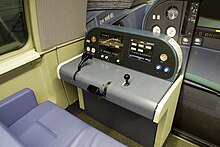
Children without paid tickets are not entitled to their own seats. In trains with unreserved seating, including all bullet trains, they are welcome to use any free seats. However, on limited expresses where all seating is reserved (eg. Narita Express, Yufuin no Mori), you are supposed to either buy them a child ticket or hold them in your lap for the entire journey, even if there are seats free, although enforcement varies. If it's peak season (eg. Golden Week), the train is looking full (marked △ or ×) or it's a long way, bite the bullet and buy them a seat.
Shinkansen bullet trains are generally well-equipped for babies. Most models come equipped with a "multi-purpose room" (多目的室 tamokuteki shitsu), which can be used for breastfeeding or changing diapers.
Children's playrooms are not standard equipment, but a few special themed trains like Tsudoi in Ise and select Uzushio/Tsurugisan services in Shikoku have them. If you happen to be traveling between Osaka and Fukuoka, some Kodama 500-series bullet trains are equipped with a kids' "control panel" (運転台 untendai) right next to the real one in carriage 8, so children can try their hand at "driving" the train!
By taxi
[edit]While children under 6 are required by law to use child seats, taxis are exempt and do not have child seats, full stop. Even digging out the back seat's middle seat belt can be a pain. If you are uncomfortable with this, the only (often poor) alternatives are to use public transport or to rent a car and drive it yourself.
See and do
[edit]Discounts for children at tourist attractions are ubiquitous in Japan, often with a range of prices depending on the exact age. The usual suspects are:
- 幼児 yōji, often glossed "infant" but usually meaning any child under 6, often free
- 子供 kodomo, child, usually 6-12 years (elementary school) or 6-15 years (elementary & middle school), typically half price
- 小学生 shōgakusei, elementary schooler (6-12 years)
- 中学生 chũgakusei, middle schooler (12-15 years)
- 高校生 kōkōsei, high schooler (15+ years), often charged adult prices
Theme parks
[edit]
Yes, there is a Tokyo Disney Resort and Universal Studios Japan in Osaka, but since you've made it all the way here, why not check out Japan's homegrown cartoon heroes instead? Some of the more ubiquitous are:
- Anpanman (アンパンマン), the "Red Bean Paste Bun Man" (yes, it's more catchy in Japanese), is a jolly bun-headed fellow who's always flying around to rescue a ridiculously huge cast of edible friends ranging from Uncle Jam to Cream Panda from the antics of the more-naughty-than-evil Baikinman (Bacteria Man). A huge favorite among the toddler/preschooler set, he's got his own "museums" — really more like themed indoor playgrounds with random Anpanman characters walking around — in Yokohama (near Tokyo), Nagoya, Kobe (near Osaka), Fukuoka and Sendai. The main museum however, is in Kami, Kochi where the author is from. In spite of its isolated location in southern Shikoku, the popularity of the character is great enough to make it among the most visited anime-related museums in the nation.
- Doraemon (ドラえもん) is a blue cat-shaped robot with a magical pocket that contains anything and everything, plus an inexplicable fondness for dorayaki pancakes. Doraemon comic books are sometimes available in English at larger bookstores. His museum in Kawasaki is, oddly, geared more for adults.
- Hello Kitty (ハローキティ) hardly needs an introduction, with her feline cuteness emblazoned onto a ludicrous range of merchandise. Harajuku remains the epicenter of the pink epidemic, but if you're still left wanting more, her theme park Sanrio Puroland is in Tama, western Tokyo.
- The painstakingly animated whimsical movies from Studio Ghibli are quintessentially Japanese, with furry Totoro (トトロ) taking pride of place among the wide cast of characters. The Ghibli Museum in Kichijoji near Tokyo is a place of pilgrimage and tickets must be booked well in advance. There is a special procedure for booking from outside Japan. Tickets in Japan can be booked via the museum website and retrieved at the Lawson convenience stores. Ghibli Park, in Nagakute near Nagoya, is a low-key rideless theme park completed in 2024.
For all of these, it will pay off to familiarize yourself (and your children) with the characters and storylines before arrival. Most of Ghibli's movies are available in English, and there are plenty of dubbed and subtitled cartoons of the other characters on YouTube and other sites as well.
Aquariums
[edit]- Okinawa Churaumi Aquarium in Okinawa is the largest aquarium in the nation, featuring a variety of fish, corals, and larger marine life, including manatees.
- Toba Aquarium in Toba features a variety of fish and aquatic animals found in the seas surrounding Ise-Shima as well as other animals, like walruses, African manatees, and it's one of only 3 aquariums in the world where you can see dugong. They also have fun sea lion shows.
- AQUAS Aquarium in Hamada, a large aquarium featuring aquatic life from around the world. The highlight of the aquarium are the famous beluga whale shows in which the belugas blow bubble rings and then swim through them.
- Nagoya Port Aquarium in Nagoya, The aquarium has a large performance tank where you can watch dolphin and killer whale shows.
Ninja
[edit]Ninja have a universal "cool" factor that attracts kids and adults alike. Japan has a handful of fun and educational ninja sites in actual former ninja towns.
- Koka was once home to the Koka (or Koga) Ninja. The rural town has two ninja sites where you can learn and experience ninja culture. The first is the Koka Ninja Village where you can test yourself on 9 different ninja skills to earn a Ninja License. The final challenge is crossing a moat. You can decide not to participate; otherwise, make sure you have a change of clothes! The other site in the city will interest adults as much as kids. Koka is home to the only authentic ninja house in existence. The Ninja House and Ninja Village are in separate locations in the town, so plan accordingly to ensure you can visit both.
- Iga Just south of Koka, the Iga Ninja formed their own school of ninjutsu. The city has its own Ninja Museum featuring popular demonstrations and a museum with information about ninja and a variety of ninja tools. The museum is located right below Iga Ueno Castle, so many visitors enjoy renting ninja costumes and getting pictures around the castle.
- Ureshino The Hizen Yume Kaido is a ninja theme park with a wide variety of ninja experiences, as well as a fun ninja performance. Concerning the city's ninja connections: Conflicts in the area during the Edo Period suggest the possibility that Saga had ninjas. It is believed that the area's famous hot springs may have even be used by the ninja as convenient places to pass on information to their hires.
Museums
[edit]
Tokyo's Miraikan in Odaiba is probably the best of the lot, but any self-respecting Japanese city will have a "science hall" (科学館 kagakukan) full of hands-on experiments and wacky science demonstrations for kids of all ages. Entry is usually free or very cheap and understanding Japanese is rarely necessary, making these a good diversion on a rainy day.
See also the Tokyo Toy Museum and nearby Fire Museum (complete with helicopters to climb in) in Shinjuku.
Railway Museums
[edit]- The Railway Museum in Saitama, outside Tokyo, is almost entirely geared for kids, with mini-trains to drive around (school age kids on their own, any age with a parent), train simulators, train-themed outdoor playground, a room filled with model trains to play with, train-shaped boxed lunches, etc. As a bonus, you can even ride the Shinkansen to get there. Packed on weekends and holidays, but quiet on weekdays.
- In Nagoya, the MC Maglev Railway and Railway Park features a variety of trains you can enter, some railway history exhibits, and some interactive experiences (some for additional fees) that are fun.
- Kyoto has its own Railway Museum featuring much of the same types of exhibits as in Saitama and Nagoya.
Game centers
[edit]
Game centers (ゲームセンター geemu-sentaa) are basically the Japanese take on the video arcade. Smaller centers, such as Taito, typically contain a wide variety of video games, including the dancing- or drumming-type rhythm games, timing or coordination games where you can win candy or stuffed animals, air hockey tables, purikura (see below) and other fun activities for children or teens. Large centers, such as Round One, often have additional activities such as karaoke, bowling, mini-bikes, mini-basketball, and other more space-consuming activities.
Purikura
[edit]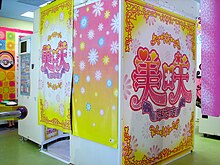
Purikura (プリクラ, short for "print club" in English) is a Japanese-style photo booth where, once you have taken your photos, you can alter or decorate them on a digital screen with handwritten messages and wide variety of effects such as adding mustaches, accessories, sparkles, or backgrounds, before printing them out as stickers or photos or emailing them to yourself in digital form. This somewhat goofy form of entertainment is wildly popular with teenagers, who are known to decorate their cell phones and everything else with stickers and even keep books full of them, but they are quite popular and enjoyable for younger children and adults as well, and silly Japanese-style photos of you and your children can make great inexpensive souvenirs. Purikura booth centers can occasionally be found as stand-alone establishments, but are more common at shopping malls, game centers, and some of the larger manga shops or bookstores.
Playgrounds
[edit]There are plenty of parks in Japanese cities, but parents will want to look for "children's parks" (児童遊園 jidōyūen or 児童公園 jidōkōen), which have play equipment and a high tolerance for kids running around. Older ones tend to be rather grim affairs of concrete and rusting monkey bars, but there are plenty of newer ones as well; Google's Street View and (if you can read Japanese) websites such as Parkful and Ikōyo (いこーよ, a guide site specifically for parents and children) can come in handy for previewing what you'll get. You can also find playgrounds on the rooftops of many major department stores, including Keio in Shinjuku and Seibu in Ikebukuro.
Buy
[edit]
Finding baby products can be a hassle, as most inner-city Japanese groceries, supermarkets, convenience stores and corner drugstores do not stock diapers (オムツ omutsu) or formula (粉ミルク kona-miruku). Do not expect to find Western brands either: the local market leaders are Kao Merries for diapers and Meiji Hohoemi for formula.
Your best bet is to look for the large, multi-story drugstores (薬局 yakkyoku) nearly always found outside larger train stations, which always prominently display the character 薬 (kusuri, "drug/medicine"). Matsumoto Kiyoshi (マツモトキヨシ) is particularly ubiquitous and easily spotted thanks to its garish yellow signage, but not all stores carry baby goods. Other major chains are KokokaraFine (ココカラファイン), Welcia (ウエルシア) and Tsuruha Drug (ツルハドラッグ).
If you want to be sure of finding what you're looking for, head for Japan's baby superstores Akachan Honpo (赤ちゃん本舗) and Nishimatsuya (西松屋). Babies'R'Us[dead link] (ベビーザらス, check on English and search) has quite a few stores in Japan as well, although most of them are awkwardly located in suburban shopping malls. Large department stores also have children's sections, but the range is often limited and prices are usually high.
For the most part, commercial Japanese baby food (ベビーフード bebii fuudo) still subscribes to the traditional belief that salt, spices and oil are all bad for babies, and is thus bland in the extreme and/or loaded up with sugar to make it palatable. If your baby already expects food to have some taste, you'll probably have better luck bringing or making your own, or sharing suitable adult foods like rice porridge (お粥 okayu, available in ready-to-eat packs).
Eat
[edit]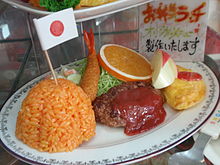
Most Japanese restaurants do not cater to babies, with highchairs (ハイチェア haicheā) being virtually unknown, and the average Tokyo hole-in-the-wall won't even have the space to park a stroller. The main exception is family restaurants (ファミレス famiresu) like Jonathan's, Royal Host, Gusto and Denny's, which can often be found near train stations and all of which offer a wide range of Japanese and Western food for both kids and adults at reasonable prices, with baby food on the menu, highchairs, etc.
Once your children reach an age where they can sit unrestrained and not make too much of a mess, things get a little easier. Larger restaurants and most all chain outlets will often have "child seats" (こども椅子 kodomo-isu), which are like a cross between a highchair and a booster seat, and kids' menus (お子様ランチ okosama lunch) featuring Japanese family favorites like fried rice wrapped in a thin omelette (オムライス omuraisu), hamburger steaks, deep-fried croquettes or mild Japanese curry, more often than not decorated with a cartoon character or arranged in a cute way. Among the Japanese fast food chains, ubiquitous beef bowl and curry chain Sukiya makes a point of being family-friendly, complete with Happy Meal-style "Suki Suki Sets" with a box of juice and a toy.
Larger Japanese restaurants may have private rooms (個室 koshitsu), often Japanese style (座敷 zashiki) with tatami mats and low tables. These are great with young kids, since they can romp around a bit without disturbing other guests, and they're usually free and available even to a single family, especially during early evening off peak hours. Just make sure to request a non-smoking room (禁煙 kin'en).
The fourth option is to do takeaway (持ち帰り mochikaeri), which is offered by a surprisingly wide range of restaurants, even at the high end of the gourmet spectrum: it's not uncommon for a Japanese salaryman to enjoy an expensive banquet on the company dime and bring back a sampling for the family. There are also plenty of shops dedicated to cheap and tasty bentō (弁当) take-away meals, although opening hours are often limited (in the inner city, often weekday morning to lunchtime only).
Last but not least, Japan's ubiquitous convenience stores are always handy in a pinch, offering onigiri rice balls, prepacked bentō meals, triangle sandwiches and other bakery goods, etc.
Sleep
[edit]Accommodation in Japan is usually charged per person, and once past the age of 12, children are considered adults when it comes to pricing. Younger children are often free as long as they sleep in the same bed, but if you ask for an extra bed, you'll be charged for it. Cribs for babies are usually free, although the age limit may be as low as 1.
Finding hotel rooms that can sleep four or more, much less with four separate beds, can be a real challenge, and most large families end up having to book two rooms. Don't try to sneak in more people, as maximum occupancy rules are a part of the fire code and usually strictly enforced.

An alternative is to book a room in a traditional Japanese inn (ryokan), which do not have beds, but where guests sleep on mattresses spread on traditional tatami mats on the floor. Ryokan often accommodate extended families, sleeping up to 8 grownups per large room. However, since food is a big part of the ryokan experience, even small children will get charged extra if you request meals for them. For preschoolers who clearly don't need adult-size portions, they're usually happy to offer a complimentary bowl of rice and bowl of miso soup while you feed them a part of your own meal. Also, since meals are usually served in your room, they can be less stressful than eating out — just try not to spill the soy sauce all over the tatami mat! Breakfast is however often served as a buffet or in a ballroom or one of the hotel restaurants, so try to be early to grab the children's high chairs. Not all ryokan accept young children as guests. Of those that do, not many are genuinely child-friendly. Smaller ryokan, minshuku and "pensions" (family-run bed and breakfast) are usually more child-friendly. It pays to do your research.
Short-stay serviced apartments are rare in Japan (bookings of one month plus are usually required), and apartments with more than one bedroom even more so. A welcome exception is Tokyu Stay, which rents out for as little as two days, has "twin" apartments that fit three, and come with basic cooking facilities and laundry/dryer. If your apartment does not have a washing machine or dryer, there are often coin laundries attached to the public bathhouses (sento) found in most neighborhoods.
Stay healthy
[edit]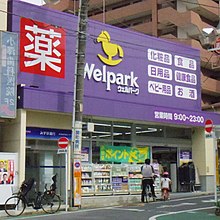
Japanese health care is generally excellent and reasonably priced, although as always you should have travel insurance to cover any major accidents.
For most issues, your first port of call should be a local pediatric clinic (小児科 shōnika), which any town of size will have several of. Clinics are typically open six days a week, sometimes Sundays as well but with reduced hours, and a basic consultation will not cost much more than ¥1000. Larger hospitals will also have pediatric wards that may accept walk-in patients, although typically only during the morning. There are English-speaking clinics in major cities, and in a pinch Nihongo de Care-Navi can translate most medical terminology.
For life-threatening emergencies that need an ambulance, call 119, which has English-speaking operators. For less urgent issues and anything outside office hours, the emergency department (救急科 kyūkyūka) of a large hospital is the best place to go, although you may be in for a long wait.
Once the issue is diagnosed (and assuming it does not require hospitalization), you will be given a stack of prescriptions (処方箋 shohōsen) to take to a pharmacy (薬局 yakkyoku). By Western standards, Japanese doctors have a distinct tendency to overprescribe, so feel free to ask what each potion does and whether it's really necessary. Medicines like antibiotics (抗生物質 kōseibusshitsu) in Japan are often issued as premeasured doses of powder, which you'll need to mix into a liquid or food of your choice. These are typically flavored and quite palatable, so one low-tech but functional method is to simply pour them in the patient's mouth and wash it down. Alternatively, pharmacies sell special jellies which are to be used to take powdered medicine.
Cope
[edit]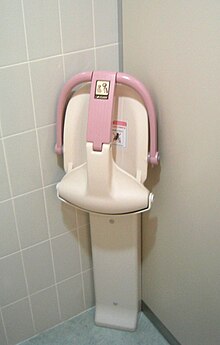
Public toilets in Japan are free and ubiquitous, and larger train stations and tourist attractions nearly always have a large toilet equipped with a change table, or at least a change table in the women's section. You may also encounter stalls equipped with a mysterious device called a "baby chair" (ベビーチェアー), basically a wall-mounted bracket with holes for legs, which is quite handy for briefly restraining inquisitive toddlers while you take care of your own business. The one thing Japanese toilets sometimes don't have, though, is toilet paper, so bring along a packet of tissues!
Breastfeeding in public is acceptable, but most Japanese women use discreet wraps that hide everything. Department stores will usually have a breastfeeding room (授乳室 junyūshitsu) or a "resting room" (休憩室 kyūkeishitsu) serving the same purpose, with larger ones (eg. Mitsukoshi in Ginza and Isetan in Shinjuku) often having an entire floor devoted to kids and parents. Almost all shopping centers and department stores have play areas for children, usually with changing rooms for babies and feeding rooms, together with an area with soft mats and blocks for the children to play. As usual in Japan, children (and adults) must remove their shoes before entering. You can easily find the nearest baby changing room with mobile apps such as "Mamamap" (in English). It also has a web version (Japanese).

